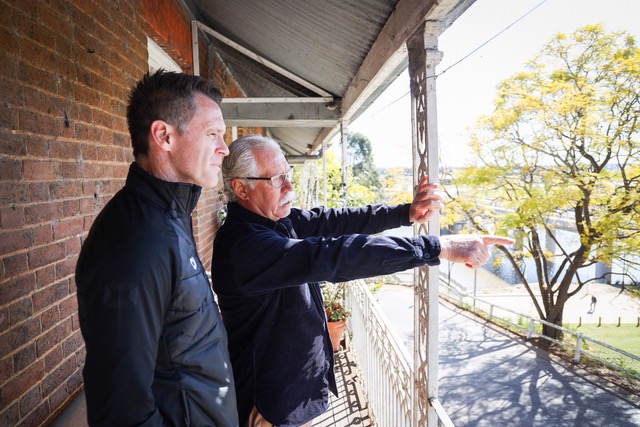From the Editor Here we are...


From the Editor Here we are...

The NSW Government is rethinking its water...

Residents and ratepayers have slammed the Hawkesbury City...

This week, bee expert Melissa Cole looks at how you get a hive and set it up. Oh, and maybe don’t pour the honey into your hands…
There’s also a useful tool guide and list of best places to get the equipment.
Hive types
There are different designs and types of beehives, including the Warre Hive, Top Bar Hive, and Flow Hive, but the Langstroth Hive design (example below) is by far the most popular, and for good reasons.

A Langstroth hive is any vertically modular beehive with these key features:
Vertically hung frames which is where the bees build honeycombs
A bottom board with entrance for the bees (ideally you want a screened base for added ventilation)
Frames for the brood (the main group of bees) and for the honey.
An inner cover and top cap for weather protection.
How a Langstroth Hive works
In a Langstroth, the bees build honeycomb into frames which can be moved with ease. The frames are designed to prevent bees from attaching honeycombs where they would either connect adjacent frames, or connect frames to the walls of the hive. The movable frames allow the beekeeper to manage the bees easily.

The key innovation in the hive’s design was the discovery of ‘bee space’ a gap size of between 6–9mm (1⁄4–3⁄8in) in which bees would not build comb, nor would they close it with propolis (otherwise known as bee glue).
Having bee space works well for the bees but also makes management of the beehive easier for the beekeeper.

A Langstroth hive has the following parts:
A bottom board. Ideally you want a screened base for added ventilation (this can be homemade or bought).
2-3 boxes which are also called brood box or honey super (these boxes are available with 8 or 10 frames. Eight-frame boxes are best). They are light and easy to handle.
Boxes are available in different heights, but to keep things simple, start with what are called full-depth boxes.
The boxes can be bought as a flat pack (all you need is some nails/ screws and outdoor paint – white or another light colour – or ready assembled and painted.

Frames are made to fit the boxes and already have the correct bee space.
Frames can be bought in a flat pack or ready assembled, wired and with foundation. Foundation is a wax sheet, so the bees will build straight down the frame, rather than all over the place), to keep it simple, buy what’s usually called ‘ready to go’ frames.
A roof (flat or pitched) homemade, flat pack or ready to go from the store.
A queen excluder – optional (either metal or plastic, to maintain a brood free honey super), available at the bee store. By using a queen excluder, the queen is contained into the brood area, as only the worker bees fit through the gaps, which leads to frames with honey only, which is what you want – that’s what you will harvest. You can’t harvest frames that contain a mix of everything, or the brood juices will end up in the honey.
An entrance reducer, to control the entrance opening. As the hive gets stronger the entrance can be opened up more (this can easily be made at home).
An inner cover (optional) for easy access to the frames. Can be homemade or bought.
A feeder frame (interior) feeder at the entrance to the hive (optional but a good asset, as weak hives or caught swarms need to be manually fed)
A hive strap, (optional), to keep the lid securely shut (available at the bee store or hardware store like Bunnings).
That’s the hive. Now let’s look at some essential tools you will need.
It’s best to buy new equipment to avoid transferring germs or diseases which could kill bees.
A smoker

A protective suit, either a half or full suit

A hive tool
Here are some of the best specialist online sites for equipment and tools. You will need to try on gloves and suit before buying, to make sure you get the right size.
It always pays to compare prices and shipping.
Where to keep the beehive
A beehive is ideally placed in a low traffic area, not visible to the public, away from passing people, machinery and ongoing garden maintenance, yet it should be easily accessible because ideally you will need a small trolley to help harvest full honey frames.
It’s a good idea to stand the hive on a small paved area, so there won’t be any grass and weeds growing around it.
The beehive should be in the sun for most of the day and ideally get some shade in the afternoon in summer, with the entry facing north/north-east.
Don’t position the hive too close to entertaining areas. Light will attract the bees at night and could cause them confusion. A hedge or wall reduces that risk.

Water
Bees need access to clean water. A strong hive can consume up to one litre a day.
For an acreage property, a nearby dam is fine (within 200m). However, if you live on a block, you might need to provide water or your bees will end up in the neighbour’s pool or spa.
A birdbath, animal drinker or similar can work well. Put rocks or floating corks in so bees won’t drown.

Beekeepers must register with the NSW Department of Primary Industries, even if you have a single hive, and you will also have to follow the DPI’s Biosecurity Code of Practice. Check here:
https://www.dpi.nsw.gov.au/animals-and-livestock/bees/beekeeper-registration
And just one word of caution before you rush out and get all the equipment – beekeeping is not for everyone. Beekeepers should expect to occasionally get stung. If you, your family or close neighbours are allergic or have an anaphylactic reaction to bee stings, obviously it’s best not to keep bees in your backyard.
Next time we’ll have a guide to bees, take a look at where you get your bees from, and which ones to choose.